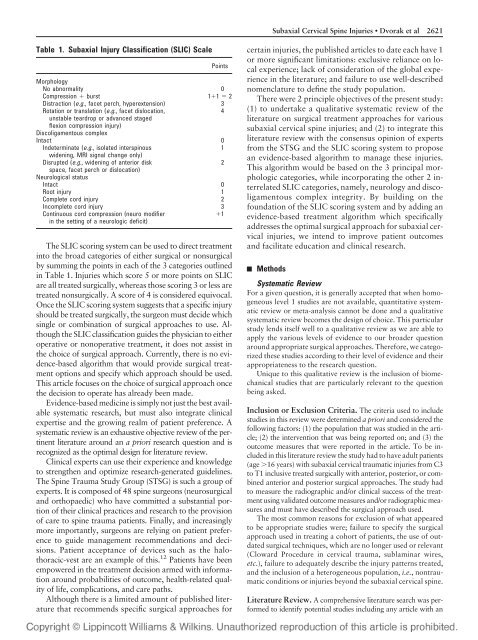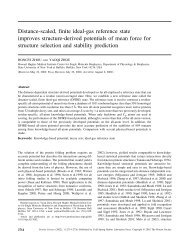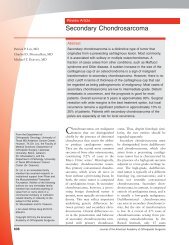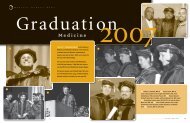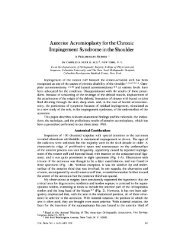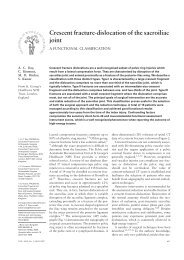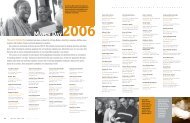The Surgical Approach to Subaxial Cervical Spine Injuries
The Surgical Approach to Subaxial Cervical Spine Injuries
The Surgical Approach to Subaxial Cervical Spine Injuries
You also want an ePaper? Increase the reach of your titles
YUMPU automatically turns print PDFs into web optimized ePapers that Google loves.
<strong>Subaxial</strong> <strong>Cervical</strong> <strong>Spine</strong> <strong>Injuries</strong> • Dvorak et al<br />
2621<br />
Table 1. <strong>Subaxial</strong> Injury Classification (SLIC) Scale<br />
Points<br />
Morphology<br />
No abnormality 0<br />
Compression burst 11 2<br />
Distraction (e.g., facet perch, hyperextension) 3<br />
Rotation or translation (e.g., facet dislocation,<br />
4<br />
unstable teardrop or advanced staged<br />
flexion compression injury)<br />
Discoligamen<strong>to</strong>us complex<br />
Intact 0<br />
Indeterminate (e.g., isolated interspinous<br />
1<br />
widening, MRI signal change only)<br />
Disrupted (e.g., widening of anterior disk<br />
2<br />
space, facet perch or dislocation)<br />
Neurological status<br />
Intact 0<br />
Root injury 1<br />
Complete cord injury 2<br />
Incomplete cord injury 3<br />
Continuous cord compression (neuro modifier<br />
1<br />
in the setting of a neurologic deficit)<br />
<strong>The</strong> SLIC scoring system can be used <strong>to</strong> direct treatment<br />
in<strong>to</strong> the broad categories of either surgical or nonsurgical<br />
by summing the points in each of the 3 categories outlined<br />
in Table 1. <strong>Injuries</strong> which score 5 or more points on SLIC<br />
are all treated surgically, whereas those scoring 3 or less are<br />
treated nonsurgically. A score of 4 is considered equivocal.<br />
Once the SLIC scoring system suggests that a specific injury<br />
should be treated surgically, the surgeon must decide which<br />
single or combination of surgical approaches <strong>to</strong> use. Although<br />
the SLIC classification guides the physician <strong>to</strong> either<br />
operative or nonoperative treatment, it does not assist in<br />
the choice of surgical approach. Currently, there is no evidence-based<br />
algorithm that would provide surgical treatment<br />
options and specify which approach should be used.<br />
This article focuses on the choice of surgical approach once<br />
the decision <strong>to</strong> operate has already been made.<br />
Evidence-based medicine is simply not just the best available<br />
systematic research, but must also integrate clinical<br />
expertise and the growing realm of patient preference. A<br />
systematic review is an exhaustive objective review of the pertinent<br />
literature around an a priori research question and is<br />
recognized as the optimal design for literature review.<br />
Clinical experts can use their experience and knowledge<br />
<strong>to</strong> strengthen and optimize research-generated guidelines.<br />
<strong>The</strong> <strong>Spine</strong> Trauma Study Group (STSG) is such a group of<br />
experts. It is composed of 48 spine surgeons (neurosurgical<br />
and orthopaedic) who have committed a substantial portion<br />
of their clinical practices and research <strong>to</strong> the provision<br />
of care <strong>to</strong> spine trauma patients. Finally, and increasingly<br />
more importantly, surgeons are relying on patient preference<br />
<strong>to</strong> guide management recommendations and decisions.<br />
Patient acceptance of devices such as the halothoracic-vest<br />
are an example of this. 12 Patients have been<br />
empowered in the treatment decision armed with information<br />
around probabilities of outcome, health-related quality<br />
of life, complications, and care paths.<br />
Although there is a limited amount of published literature<br />
that recommends specific surgical approaches for<br />
certain injuries, the published articles <strong>to</strong> date each have 1<br />
or more significant limitations: exclusive reliance on local<br />
experience; lack of consideration of the global experience<br />
in the literature; and failure <strong>to</strong> use well-described<br />
nomenclature <strong>to</strong> define the study population.<br />
<strong>The</strong>re were 2 principle objectives of the present study:<br />
(1) <strong>to</strong> undertake a qualitative systematic review of the<br />
literature on surgical treatment approaches for various<br />
subaxial cervical spine injuries; and (2) <strong>to</strong> integrate this<br />
literature review with the consensus opinion of experts<br />
from the STSG and the SLIC scoring system <strong>to</strong> propose<br />
an evidence-based algorithm <strong>to</strong> manage these injuries.<br />
This algorithm would be based on the 3 principal morphologic<br />
categories, while incorporating the other 2 interrelated<br />
SLIC categories, namely, neurology and discoligamen<strong>to</strong>us<br />
complex integrity. By building on the<br />
foundation of the SLIC scoring system and by adding an<br />
evidence-based treatment algorithm which specifically<br />
addresses the optimal surgical approach for subaxial cervical<br />
injuries, we intend <strong>to</strong> improve patient outcomes<br />
and facilitate education and clinical research.<br />
Methods<br />
Systematic Review<br />
For a given question, it is generally accepted that when homogeneous<br />
level 1 studies are not available, quantitative systematic<br />
review or meta-analysis cannot be done and a qualitative<br />
systematic review becomes the design of choice. This particular<br />
study lends itself well <strong>to</strong> a qualitative review as we are able <strong>to</strong><br />
apply the various levels of evidence <strong>to</strong> our broader question<br />
around appropriate surgical approaches. <strong>The</strong>refore, we categorized<br />
these studies according <strong>to</strong> their level of evidence and their<br />
appropriateness <strong>to</strong> the research question.<br />
Unique <strong>to</strong> this qualitative review is the inclusion of biomechanical<br />
studies that are particularly relevant <strong>to</strong> the question<br />
being asked.<br />
Inclusion or Exclusion Criteria. <strong>The</strong> criteria used <strong>to</strong> include<br />
studies in this review were determined a priori and considered the<br />
following fac<strong>to</strong>rs: (1) the population that was studied in the article;<br />
(2) the intervention that was being reported on; and (3) the<br />
outcome measures that were reported in the article. To be included<br />
in this literature review the study had <strong>to</strong> have adult patients<br />
(age 16 years) with subaxial cervical traumatic injuries from C3<br />
<strong>to</strong> T1 inclusive treated surgically with anterior, posterior, or combined<br />
anterior and posterior surgical approaches. <strong>The</strong> study had<br />
<strong>to</strong> measure the radiographic and/or clinical success of the treatment<br />
using validated outcome measures and/or radiographic measures<br />
and must have described the surgical approach used.<br />
<strong>The</strong> most common reasons for exclusion of what appeared<br />
<strong>to</strong> be appropriate studies were; failure <strong>to</strong> specify the surgical<br />
approach used in treating a cohort of patients, the use of outdated<br />
surgical techniques, which are no longer used or relevant<br />
(Cloward Procedure in cervical trauma, sublaminar wires,<br />
etc.), failure <strong>to</strong> adequately describe the injury patterns treated,<br />
and the inclusion of a heterogeneous population, i.e., nontraumatic<br />
conditions or injuries beyond the subaxial cervical spine.<br />
Literature Review. A comprehensive literature search was performed<br />
<strong>to</strong> identify potential studies including any article with an


